
What is IPD?
IPD, or Interpupillary Distance, is defined as the distance between the centers of the pupils of the eyes. This measurement plays a vital role in the field of vision and eyewear, as it affects how lenses are aligned in eyeglasses and various optical devices. The accurate measurement of one’s IPD is essential for ensuring that optical lenses are positioned correctly, thereby optimizing vision clarity and comfort.
The relevance of IPD extends beyond just basic measurements; it is crucial for various forms of vision correction, including single vision, multifocal, and progressive lenses. If the lenses are not aligned with the individual’s pupils, it can lead to discomfort, eye strain, and even distortion of vision. This highlights the importance of knowing “what’s my IPD” before making eyewear purchases.
Furthermore, IPD can vary significantly among individuals. Factors such as age, ethnicity, and personal eye anatomy can influence this measurement, leading to a wide range of standard IPD values. For example, the average adult IPD typically ranges from 54 to 74 millimeters, yet some individuals may have measurements that fall above or below this range. This variability underscores the necessity for personalized measurements during eye exams, especially for those seeking vision correction.
In addition, an incorrect IPD measurement can substantially affect the effectiveness of prescribed lenses. For those who require corrective eyewear, misunderstanding or neglecting the importance of correct IPD might lead to unsatisfactory visual outcomes. Knowing “what’s my IPD” can empower individuals to make informed decisions regarding their optical health and enhance their overall visual experience.
Why is IPD Important?
The interpupillary distance (IPD) is a critical measurement in the realm of optical devices, playing a significant role in ensuring visual comfort and effectiveness. Correct IPD measurements are essential for various applications, including prescription eyewear, virtual reality (VR) headsets, and binoculars.
An inappropriate IPD can lead to a range of issues, including discomfort, eye strain, and reduced visual performance. For individuals who rely on corrective lenses, such as glasses or contact lenses, accurate IPD is pivotal for aligning the optical centers of the lenses with the pupils. When this alignment is off, users may experience blurred vision, headaches, or other forms of visual fatigue, compromising their everyday visual experience.
Moreover, the importance of IPD extends beyond personal eyewear. In the context of VR headsets, the user’s IPD must be finely adjusted to provide a seamless and immersive experience. A mismatched IPD in VR technology can result in discomfort, dizziness, and an overall negative experience, detracting from the intended benefits of this innovative technology. As users are often engaged in these environments for extended periods, ensuring the correct IPD becomes crucial for prolonged enjoyment and engagement.
Binoculars also necessitate precise IPD adjustments, as an improper setting can lead to double vision or an inability to focus correctly on distant objects. This misalignment can diminish the user’s ability to appreciate landscapes or wildlife clearly. Consumers, therefore, should not overlook IPD when considering the purchase of optical devices or custom lenses. Attention to this detail guarantees optimal performance and a more satisfying optical experience. Understanding what your IPD is and ensuring it aligns with the specifications of your optical devices can significantly enhance your overall visual comfort and effectiveness.
IPD Facts & Data
- The average adult IPD: 63mm for males, 61mm for females.
- Children’s IPD grows rapidly until around age 15.
- IPD affects lens centering and visual acuity significantly.
- Incorrect IPD in VR can cause motion sickness within 15–30 minutes of use.
- Standard binoculars offer an adjustable IPD range of 55–75mm.
How to Measure Your IPD?
Measuring your interpupillary distance (IPD) can seem daunting, but with the right techniques and tools, it can be done with relative ease. This measurement is crucial for ensuring that optical devices, such as glasses, align properly with your eyes for the best visual experience.
To begin, when measuring at home, you will need a ruler, a mirror, or even your smartphone. First, stand in front of a mirror and hold a ruler against your brow, positioning it horizontally. Close your right eye and note the measurement where the center of your left pupil aligns with the ruler. Next, close your left eye and open your right eye, again noting the ruler’s measurement where your right pupil aligns. The distance between these two measurements gives you your IPD, typically measured in millimeters.
If you prefer using a smartphone, several apps are designed for this purpose. These apps usually use augmented reality technology to provide an accurate IPD reading. Simply follow the on-screen instructions to capture the measurement effectively.
When visiting an optometrist, they will employ specialized equipment to measure your IPD accurately. This is typically done using a pupillometer, which provides precise readings. One advantage of visiting a professional is that they can ensure the measurement process is done accurately and can provide additional insights based on your vision needs.
Common Measurement Mistakes
| Mistake | Cause | Effect | Solution |
|---|---|---|---|
| Ruler misalignment | Not level with pupils | Incorrect IPD reading | Use flat mirror & steady ruler |
| Incorrect pupil center estimation | Eyeball movement | Blurred vision in glasses | Mark pupil centers lightly or use assistant |
| Poor lighting | Shadow on pupils | Measurement errors | Use bright, natural light |
| Smartphone app misuse | Improper positioning | Inaccurate digital measurement | Follow app instructions carefully |
Different Methods of Measuring IPD
Measuring interpupillary distance (IPD) is a crucial aspect for ensuring proper vision, particularly when using optical devices like glasses and binoculars. Various methods exist to determine what’s my IPD, each with its own advantages and limitations. Understanding these methods can help individuals select the most suitable approach for their needs.
One of the most traditional methods involves the use of a millimeter ruler. This method requires an individual to stand in front of a mirror, positioning the ruler against their brow, and measuring the distance between the pupils. While simple and cost-effective, this technique may introduce a level of error, especially if the individual does not align the ruler accurately. Furthermore, it may be difficult for one to gauge precise measurements without another person’s assistance.
Dedicated measuring devices, such as pupillometers, offer a more accurate option. These devices are specifically designed to measure IPD with precision, allowing for quick readings that enhance accuracy significantly compared to manual methods. Although more expensive, they are commonly used by opticians in clinical settings and can help ensure the correct distance for lenses, thereby improving the overall efficiency of fitting eyewear.
Smartphone applications also present an accessible and convenient alternative for measuring IPD. Many of these apps utilize augmented reality technology to provide users with readings based on camera input. While convenient, the accuracy of these applications may vary, and users should be cautious to follow the application’s instructions carefully to achieve reliable results.
Professional opticians utilize advanced techniques, such as corneal reflex measurements and digital imaging, to determine an individual’s IPD with exceptional accuracy. These methods ensure that measurements are precise during optometric exams, ultimately enhancing patient experience and satisfaction. Understanding these different methods to measure IPD empowers individuals to make informed decisions on which approach will meet their needs effectively.
IPD in Children vs. Adults
Inter-pupillary distance (IPD) is a vital measurement obtained by assessing the distance between the centers of the pupils in the eyes. This measurement plays a significant role in ensuring proper fitting of optical devices such as glasses and binoculars. When it comes to IPD, notable differences exist between children and adults, primarily due to developmental factors. Children’s IPD can change rather significantly over time as they grow, indicating that regular IPD assessments are essential during their developmental years.
In children, the IPD typically measures smaller than in adults and can increase as they age. This growth pattern underscores the importance of monitoring IPD frequently, particularly as children reach critical growth phases, such as during puberty. A child’s IPD can shift as much as 10 to 15 millimeters over the span of several years, making accurate and up-to-date measurements crucial for maintaining proper optical alignment and comfort in eyewear.
Parents should be cognizant of the implications that varying IPD has on their child’s eyewear needs. An incorrectly measured IPD could result in discomfort, ineffective vision correction, or even eye strain. It is advisable for parents to engage with qualified optical professionals who can provide accurate IPD measurements, ensuring that the glasses fit properly according to the child’s current development stage.
In adults, IPD tends to stabilize, making it less subject to change over time. However, understanding the differences in IPD between adults and children not only helps in proper eyewear fitting but also raises awareness about eye health. It is vital for parents to prioritize these measurements, especially when looking to purchase eyewear for their children, to guarantee optimal vision care.
IPD Growth Table by Age
| Age Group | Average IPD (mm) | Notes |
|---|---|---|
| 0-1 years | 36-42 | Rapid growth phase |
| 2-5 years | 42-48 | Frequent reassessment recommended |
| 6-12 years | 48-55 | Growth slows gradually |
| 13+ years | 55-74 | Adult IPD established |
Common IPD Misconceptions
IPD, or interpupillary distance, is often surrounded by various misconceptions that can lead to confusion and misunderstanding. A prevalent myth is that IPD is a fixed number applicable to everyone. In reality, IPD varies significantly among individuals, influenced by factors such as age, facial structure, and the distance between the pupils. This individualized measurement is crucial for ensuring proper alignment of optical devices, such as eyeglasses and binoculars, which are designed to accommodate the specific visual needs of each person.
Another misconception is the belief that IPD does not impact vision clarity. This idea is misleading; an improper IPD can result in visual discomfort, eye strain, or blurred vision. Proper alignment is essential for maximizing the effectiveness of corrective lenses, as misalignment can lead to distortions in how light is processed by the eyes. It is vital to have an accurate measurement of one’s IPD for all visual aids, as it directly influences how well one sees through lenses.
In addition, some people may believe that IPD only matters for those with vision disorders. However, every individual, regardless of their visual acuity, benefits from understanding their IPD. Knowing one’s correct measurement helps in selecting suitable eyewear and other optical devices, contributing to overall visual well-being. Disregarding the importance of this measurement could lead to poor device functionality and an unnecessary increase in eye-related complications.
Buying Glasses Online: How IPD Affects Your Choices
Purchasing glasses online presents unique challenges, particularly when it comes to understanding your interpupillary distance (IPD). The IPD is a crucial measurement that indicates the distance between the centers of your pupils. An accurate IPD measurement is essential for ensuring that the optical centers of the lenses align with your eyes, thereby significantly enhancing visual comfort and clarity.
Many online retailers offer tools that help customers measure their IPD using a standard ruler or smartphone camera. These resources can simplify the process and allow users to obtain their measurements with ease. For more guidance on accurate measurement, you can consult AAO Eye Health.
However, it is vital to be aware that not all online providers have the same level of support or technology for capturing accurate IPD measurements. Some retailers may even have automatic adjustment options to help cater to a wide variety of IPDs, but having your exact measurement ensures the best fit. When shopping for glasses online, it is advisable to look for retailers that emphasize the significance of providing your IPD and offer instructions for measuring it accurately. This attention to detail can make a marked difference in your overall satisfaction with your purchase.
IPD and Virtual Reality: A New Frontier
As virtual reality (VR) technology advances and becomes increasingly mainstream, understanding the interplay between inter-pupillary distance (IPD) and the VR experience is essential. The IPD refers to the distance between the centers of the pupils of the eyes, and it plays a critical role in achieving a comfortable and immersive VR experience. Each VR headset is designed with a fixed or adjustable IPD setting, which is crucial for ensuring that the displayed images align perfectly with the user’s eyes. Misalignment can lead to discomfort, blurriness, or even motion sickness during usage.
To derive maximum benefit from a VR headset, it is important to adjust the headset’s IPD to match the user’s own measurements. If the IPD is not configured correctly, users may find themselves straining their eyes or experiencing a less engaging virtual environment. The immersive quality of VR, which transports users into detailed 3D worlds, heavily relies on the ability to perceive depth and clarity. By aligning the headset’s optics with individual IPD, users can experience a more realistic field of view, enhancing both immersion and enjoyment. Many VR manufacturers include IPD measurement guidance in their product descriptions, emphasizing the importance of this adjustment. Custom setup options are also being increasingly integrated into VR technologies, allowing users to personalize their experience.
Conclusion: The Importance of Personalized IPD Measurements
Understanding and accurately measuring one’s interpupillary distance (IPD) plays a crucial role in ensuring optimal vision, comfort, and the overall effectiveness of optical devices. The IPD refers to the distance between the centers of the pupils in each eye, and this measurement is vital for various applications, particularly in the realm of eyewear. When individuals ask themselves, “what’s my IPD,” they are engaging in a key aspect of eye health that can significantly influence their visual experience.
Having a precise IPD measurement can enhance the performance of prescription glasses, contact lenses, and even virtual reality headsets. Incorrect IPD can lead to discomfort, visual fatigue, or distorted vision. As the lenses are designed to align perfectly with the pupils, an improperly measured IPD can negate the optical benefits intended by the eyewear.
For further guidance on optical alignment and lens fitting, visit AOA Eye Care.
Furthermore, it is advisable for readers to regularly verify their IPD, as vision can change over time. Factors such as age, eye health, and prescription adjustments can all necessitate a reevaluation of this measurement. By maintaining an accurate understanding of their IPD, individuals can safeguard their eye health and enhance their visual comfort with each pair of glasses or lenses they utilize. Therefore, adopting a proactive approach to tracking and measuring the IPD can lead to improved outcomes and a more satisfying visual experience.








